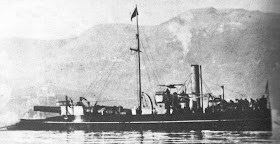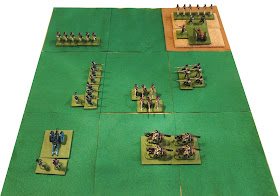Having been beaten at the Battle of the Leipzig Gap, the Prussian 3rd Division had fallen back to a position to the southeast of Leipzig.
A map showing the strategic situation before the battle.
It had been able to regain some of its strength by absorbing new recruits into its ranks, but it was still a lot weaker than it had been, and it was unable to outrun the French 4th Division.
Situation
The Prussian 3rd Division retreated after their defeat at the Battle of the Leipzig Gap. They were pursued by the French 4th Division who caught up with them southeast of Leipzig.
The French force was the 4e Division d’Infanterie/4th Infantry Division. It was commanded by General Torrance and comprised:
- 13e Régiment d’Infanterie/13th Infantry Regiment (Average)
- 14e Régiment d’Infanterie/14th Infantry Regiment (Average)
- 15e Régiment d’Infanterie légère/15th Light Infantry Regiment (Average)
- 16e Régiment d’Infanterie légère/16th Light Infantry Regiment (Average)
- 4e Régiment d’Artillerie/4th Artillery Regiment (Average)
- 4e Regiment de Cuirassier/4th Cuirassier Regiment (Average)
The Prussian force was the under-strength 3. Infanterie-Division/3rd Infantry Division. It was commanded by General von Horn and comprised:
- 9. Infanterie-Regiment/9th Infantry Regiment (Poor; reduced to 2 SPs)
- 10. Infanterie-Regiment/10th Infantry Regiment (Poor; reduced to 2 SPs)
- 11. Infanterie-Regiment/11th Infantry Regiment (Poor; reduced to 2 SPs)
- 12. Infanterie-Regiment/12th Infantry Regiment (Poor; reduced to 2 SPs)
- 3. Artillerie-Regiment/3rd Artillery Regiment (Poor; reduced to 1 SP)
The Terrain
The French Reserve Area is on the left of the map and the Prussian Reserve Area is on the right.
The battlefield's terrain. The Prussian Reserve Area is nearest to the camera.
The pursuit of the Prussian 3rd Division
Initial positions
General Torrance positioned his artillery (4th Artillery Regiment) on the hill and took up a position alongside it. Behind the artillery he deployed 14th Infantry Regiment in line. In the centre he placed his two light infantry units (15th Light Infantry Regiment and 16th Light Infantry Regiment) in a contiguous column, and on his right he deployed the 13th Infantry Regiment in line with the 4th Cuirassier Regiment in line behind them.
General von Horn positioned his artillery (3rd Artillery Regiment) on his left, with the 12th Infantry Regiment in line behind them. He also chose to accompany these two units. He deployed the 19th and 11th Infantry Regiments in lone in the centre and the 9th Infantry Regiment in line on his right.
The initial positions of both sides. The Prussian 3rd Division is nearest the camera..
Turn 1
The French immediately attacked the Prussian force.
The French 4th Artillery fired at the Prussian 9th Infantry Regiment, causing them to lose 1 SP.
In the centre both the French 15th and 16th Light Infantry Regiments advanced in a single column. This gave room for the 4th Cuirassiers to change formation into column and move into the area formerly occupied by them.
On the right, the French 13th Infantry Regiment moved forward towards the Prussian 3rd Artillery and 12th Infantry Regiments.
In response, the Prussian 3rd Artillery Regiment fired at the advancing French 13th Infantry Regiment ... and missed! Likewise, in the centre the two Prussian infantry units fired at the oncoming French column and also missed!
The situation at the end of Turn 1.
Turn 2
As pressure on them increased, the Prussians responded.
The Prussian 12th Infantry Regiment advanced and fired at the French 13th Infantry Regiment, which lost 1 SP.
The Prussian 3rd Artillery Regiment also fired at the French 13th Infantry Regiment, which fell back to its original position.
In the centre, the two Prussian infantry units fired at the French column and inflicted the loss of 1 SP on both the French 15th and 16th Light Infantry Regiments.
At this point things were beginning to look good for the Prussians ... and then the French 4th Artillery Regiment fired at the already weakened Prussian 9th Infantry Regiment ... and destroyed it!
The French column continued its advance and engaged the Prussian 10th and 11th Infantry Regiments in Close Combat, inflicting the loss of 1 SP on each of the Prussian units.
The French 4th Cuirassiers moved forward onto the flank of the French column in the centre of the battlefield.
The situation at the end of Turn 2.
Turn 3
The fighting in the centre of the battlefield continued. The French 15th Light Infantry Regiment destroyed the Prussian 10th Infantry Regiment, losing 1 SP in the process. The French 16th Infantry Regiment was unable to match this achievement, but the 4th Cuirassiers charged the Prussian 11th Infantry in the flank and destroyed them!
The Prussian 3rd Artillery Regiment fired at the French 13th Infantry Regiment ... and missed.
The Prussian 12th Infantry Regiment, led by General von Horn, moved forward, and turned right, firing into the flank of the French 16th Light Infantry Regiment, which was forced to fall back.
The situation at the end of Turn 3.
Turn 4
The French 13th Infantry Regiment advance and engaged the Prussian 12th Infantry Regiment in Close Combat from the flank. The Prussians fought well and force the French 13th Infantry Regiment to fall back ... but the Prussian 12th Infantry Regiment was all but destroyed in the process.
Seeing the his remaining troops were unable to continue fighting much longer and wanting to avoid further bloodshed, General von Horn surrendered to General Torrance.
The situation at the end of Turn 4 and tat he end of the battle.
The French had lost 4 SPs and the Prussians had lost 7 SPs.
Aftermath
The destruction of the Prussian 3rd Division convinced the King of Prussia that his army could not win the war. He immediately requested an armistice whilst matters between the two nations were settled.
The Emperor of France was magnanimous in victory. In exchange for the exclusive right to buy Prussian's grain harvest for the next five years and the payment of 100,000 gold Thalers, he agreed to withdraw his troops from Prussia.
As to the original cause of the war (a Prussian leaflet that had been printed lampooning the Emperor of France), the author of the pamphlet and the printer who had printed and distributed it were encouraged by the Prussian police to emigrate as soon as possible!



















































